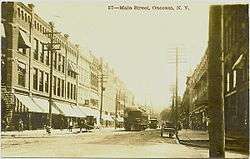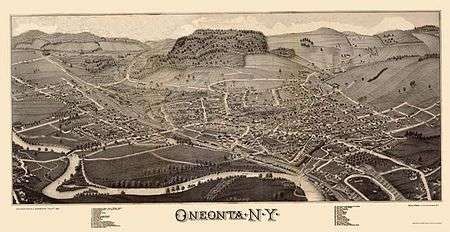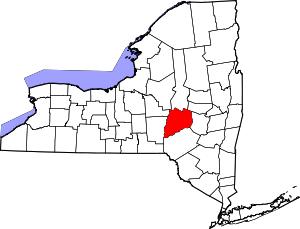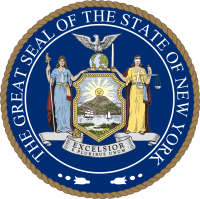Oneonta, New York
Oneonta (/ˌoʊniˈɒntə/ OH-nee-ON-tə) is a city in southern Otsego County, New York, United States. It is one of the northernmost cities of the Appalachian Region. According to the 2010 U.S. Census, Oneonta had a population of 13,901.[3] Its nickname is "City of the Hills." While the word "oneonta" is of undetermined origin, it is popularly believed to mean "place of open rocks" in the Mohawk language. This refers to a prominent geological formation known as "Table Rock" at the western end of the city.
Oneonta | |
|---|---|
City | |
City Hall (formerly the post office) | |
| Nickname(s): "City of the Hills" | |
 Oneonta Location of Oneonta in New York | |
| Coordinates: 42°27′21″N 75°3′44″W | |
| Country | United States |
| State | New York |
| County | Otsego |
| Region | Appalachian Region |
| Incorporated (village) | 1842 |
| Incorporated (city) | 1908 |
| Government | |
| • Type | Mayor-Council |
| • Mayor | Gary Herzig (D) |
| • Common Council | Members' List
|
| Area | |
| • Total | 4.36 sq mi (11.31 km2) |
| • Land | 4.36 sq mi (11.30 km2) |
| • Water | 0.00 sq mi (0.01 km2) |
| Population (2010) | |
| • Total | 13,901 |
| • Estimate (2019)[2] | 13,907 |
| • Density | 3,188.95/sq mi (1,231.19/km2) |
| ZIP codes | 13820 |
| Area code(s) | 607 |
| FIPS code | 36-54881 |
| Website | Official website |
The city is surrounded by the town of Oneonta, a separate municipal and political jurisdiction. Oneonta Municipal Airport (N66) is north of the city.
History

Indigenous ancestors of Algonquin and Iroquoian-speaking Native Americans inhabited the land in the territory of Oneonta for thousands of years before European colonists settled in the area. The Five Nations of the Iroquois Confederacy are believed to have emerged and gained dominance prior to the 15th century; they were in place at the time of early French and Dutch colonization.
The area's early European-American settlers did not arrive until around 1775 and consisted mainly of ethnic Palatine German and Dutch settlers moving out of the Hudson and eastern Mohawk valleys. The first such settler in the area now known as the Town of Oneonta was Henry Scramling (b. ~1743; d. 1808). He had secured a grant of 1,000 acres in the Susquehanna Valley, moved from German Flatts and settled about 1773 in the Oneonta Plains near the mouth of the Otego Creek. He left during the Revolution and returned after the conflict with his brothers, George and David Scramling, and his brothers-in-law, John and David Young. Their farms were not far from the mouth of the Otego Creek.[4] The army led by General James Clinton passed through the area in order to join the Sullivan Expedition in 1779 against Iroquois settlements.
The first hamlet developed around 1800 and was later known as "Milfordville." In 1830, the Town of Oneonta was formed from parts of two other Towns in the county. Milfordville changed its name to Oneonta in 1832. In 1848, it was incorporated as a village within the Town.
In the mid-19th century, the Delaware and Hudson Railroad reached Oneonta, stimulating development as a railroad center and attracting new industries. Oneonta was once home to the largest locomotive roundhouse in the world.[5]
The village incorporated as a city in 1908.

Geography
Oneonta is located at 42°27′21″N 75°3′44″W (42.456003, -75.062302).[6] According to the United States Census Bureau, the city has a total area of 4.4 square miles (11.3 km²), all land.
The city lies between Binghamton and Albany.
The Susquehanna River flows westward past the south part of the city.
Interstate 88 follows the course of the Susquehanna River past Oneonta. New York State Route 7, New York State Route 23 and New York State Route 28 pass through the city.
Architecture
The architecture of Oneonta consists of a variety of Victorian and 20th-century commercial and domestic styles, including low-rise commercial buildings. Oneonta currently has very few industrial complexes. Because of its location, Oneonta does not serve as a prime industrial city.
There are several historic buildings that were originally homes of prominent people. The Fairchild Mansion was placed on the National Register of Historic Places in 1974 and was formerly the home of George Winthrop Fairchild, one of the original partners with Thomas Watson. Fairchild and Watson were the founders of what eventually became IBM. Also, George I. Wilber House is a historic home located in the City. It was built in two phases, 1875 and about 1890. It is a three-story wood-frame structure on a stone foundation in the Late Victorian style. It features a three-story, round corner tower, cross gabled roof, and a large, very decorative wrap-around porch with a porte-cochere. In 1997 it became home to the Upper Catskill Community Council of the Arts (now the Community Arts Network of Oneonta). It was listed on the National Register of Historic Places in 2000.[7]
Also listed on the National Register of Historic Places are: Bresee Hall, Chapin Memorial Church, Ford Block, Fortin Site, Municipal Building, Oneonta Armory, Stonehouse Farm, Oneonta Theatre, Old Post Office, Oneonta Downtown Historic District, and Walnut Street Historic District.[7]
The tallest building in Oneonta is Nader Towers. Standing 9 stories high, the building is owned by the City of Oneonta Housing Authority and is operated as a senior citizen's housing dwelling.
Demographics
| Historical population | |||
|---|---|---|---|
| Census | Pop. | %± | |
| 1870 | 1,061 | — | |
| 1880 | 3,002 | 182.9% | |
| 1890 | 6,272 | 108.9% | |
| 1900 | 7,147 | 14.0% | |
| 1910 | 9,491 | 32.8% | |
| 1920 | 11,582 | 22.0% | |
| 1930 | 12,536 | 8.2% | |
| 1940 | 11,731 | −6.4% | |
| 1950 | 13,564 | 15.6% | |
| 1960 | 13,412 | −1.1% | |
| 1970 | 16,030 | 19.5% | |
| 1980 | 14,933 | −6.8% | |
| 1990 | 13,954 | −6.6% | |
| 2000 | 13,292 | −4.7% | |
| 2010 | 13,901 | 4.6% | |
| Est. 2019 | 13,907 | [2] | 0.0% |
| U.S. Decennial Census[8] | |||

As of the census of 2000, there were 13,292 people, 4,253 households, and 1,913 families residing in the city. The population density was 3,032.6 people per square mile (1,171.7/km²). There were 4,574 housing units at an average density of 403.2 persons/km² (1,043.6 persons/sq mi). The racial makeup of the city was 89.81% White, 4.87% Black, 0.21% Native American, 1.68% Asian, 0.09% Pacific Islander, 0.95% from other races, and 1.69% from two or more races. 3.87% of the population were Hispanic or Latino of any race.
There were 4,253 households out of which 22.1% had children under the age of 18 living with them, 31.4% were married couples living together, 10.5% have a woman whose husband does not live with her, and 55.0% were non-families. 36.4% of all households were made up of individuals and 13.5% had someone living alone who was 65 years of age or older. The average household size was 2.20 and the average family size was 2.87.
In the city, the population was spread out with 13.6% under the age of 18, 43.1% from 18 to 24, 17.6% from 25 to 44, 13.8% from 45 to 64, and 11.8% who were 65 years of age or older. The median age was 23 years. For every 100 females, there were 82.8 males. For every 100 females age 18 and over, there were 80.7 males.
The median income for a household in the city was $24,671, and the median income for a family was $40,833. Males had a median income of $31,250 versus $25,338 for females. The per capita income for the city was $12,640. 30.3% of the population and 13.5% of families were below the poverty line. Out of the total people living in poverty, 20.8% are under the age of 18 and 12.6% are 65 or older.
City government
Current members of the City's government can be viewed by visiting the City's website. The website includes a broad range of information about the City and City government, including a calendar of all governmental meetings, copies of Common Council minutes and the complete text of the City Code.
Education
Oneonta is home to the State University of New York at Oneonta (often abbreviated to SUNY Oneonta) and Hartwick College. SUNY Oneonta began in Oneonta as a normal school and a teacher's college in 1889, and Hartwick College moved into the city in 1928. The approximately 5,800 students from SUNY Oneonta and the approximately 1,500 students at Hartwick make up a significant percentage of the population of Oneonta.
Oneonta City School District (OCSD) enrolls students from the communities of the City of Oneonta, the Town of Oneonta, the town of Davenport, the town of Laurens, and the town of Milford. OCSD has one high school, Oneonta High School, which has about 650 students; one middle school, Oneonta Middle School, which has about 300 students; and three elementary schools; Greater Plains, Riverside, and Valleyview which have a total enrollment of about 900.
A fourth elementary school, Center Street School, was closed in June 2012 due to declining enrollment and decreased funding from New York State.
Parks and recreation
The city of Oneonta operates two major municipal parks, Neahwa Park and Wilber Park.[9]
Damaschke Field, home of the Oneonta Outlaws of the Perfect Game Collegiate Baseball League (PGCBL), is located in Neawha Park.
Infrastructure
Interstate 88 goes through the outskirts of the city. New York State Route 7 and New York State Route 23 pass through the center of the town. Until 1963 the Delaware & Hudson Railway ran a Binghamton-Albany passenger train through the town.[10][11]
Centennial
In 2008 the city of Oneonta celebrated its Centennial with monthly events throughout the year beginning with the New Year's Eve parade.[12]
Notable people
- Scott Adams, cartoonist, attended Hartwick College in Oneonta.
- Dylan Avery and Korey Rowe, creators of the Loose Change 9/11 conspiracy films, grew up together in Oneonta.
- Clay Bellinger, former major league baseball player, was born and raised in Oneonta.
- Wendell Brown, entrepreneur and inventor, was raised in Oneonta and graduated from Oneonta High School.[13]
- Karl Coryat, writer, grew up in Oneonta and nearby Cooperstown.
- George Winthrop Fairchild, businessman and IBM chairman, was born in Oneonta.
- Sherman Mills Fairchild, inventor, was born in Oneonta.
- Al Gallodoro, musician and Hartwick professor, lived and died in Oneonta.
- Herb Green, architect and artist, was born in Oneonta in 1929.
- Augustus M. Gurney, Brigadier general, U.S. Army; born and lived in Oneonta
- Henry E. Huntington, railroad magnate, developer of Beverly Hills, California, born in Oneonta.
- Jim Konstanty, baseball pitcher, was the athletic director at Hartwick College and died in Oneonta.[14]
- Mark May, professional football player and sportscaster, was born in Oneonta.
- Jim Metzler, actor, was born in Oneonta.
- Erik Neander, GM of the Tampa Bay Rays and 2019 MLB Executive of the Year, attended Oneonta High School.
- Bill Pullman, actor, received his BA in theater from SUNY Oneonta.
- Paul Reubens, actor, spent a significant amount of his childhood in Oneonta.
- Larry Santos, songwriter, singer and television personality, was born in Oneonta.
- Frances Starr, actress, was born in Oneonta.
- Louise Hall Tharp - biographer
- Jerry Jeff Walker, country music singer, was born in Oneonta.
- Carleton E. Watkins, 19th century California nature photographer, was born in Oneonta.
References
- "2019 U.S. Gazetteer Files". United States Census Bureau. Retrieved July 27, 2020.
- "Population and Housing Unit Estimates". United States Census Bureau. May 24, 2020. Retrieved May 27, 2020.
- "U.S. Census website". United States Census Bureau. Retrieved 2008-01-31.
- "Scramling Cemetery, West Oneonta, NY". Retrieved 2012-07-06.
- New York, Oneonta. "History of Oneonta". Oneonta.New York.US. Archived from the original on 2006-11-13. Retrieved 2006-11-25.
- "US Gazetteer files: 2010, 2000, and 1990". United States Census Bureau. 2011-02-12. Retrieved 2011-04-23.
- "National Register Information System". National Register of Historic Places. National Park Service. March 13, 2009.
- "Census of Population and Housing". Census.gov. Retrieved June 4, 2015.
- "Visit Oneonta NY :: Parks and Recreation". www.oneonta.ny.us. Retrieved 11 August 2017.
- "Delaware & Hudson Passenger Train Demise" https://penneyvanderbilt.wordpress.com/2016/02/26/delaware-hudson-passenger-train-demise/
- Susquehanna Valley Railway Historical Society, April–June, 2012 http://www.trainweb.org/SVRHS/SVRHS_FeedwaterHeater_2012_2Q.pdf
- "argianpress.net". www.argianpress.net. Archived from the original on 11 August 2017. Retrieved 11 August 2017.
- "Oneonta High Alumni Association". www.oneontahighalumni.org. Retrieved 11 August 2017.
- Ralph Berger. "Jim Konstanty". SABR Baseball Biography Project. Retrieved December 16, 2010.
External links
| Wikimedia Commons has media related to Oneonta (city), New York. |

